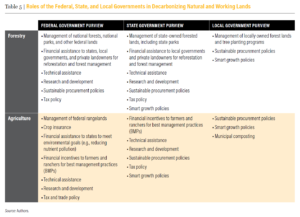An effective response to climate change in the United States will require coordinated, collaborative action by federal, state and local governments. The improved management of natural and working lands is a key component of an all-hands-on-deck carbon mitigation strategy.
New Climate Federalism: Effectively Addressing Climate Change Requires Action At All Levels of Government
World Resources InstituteWorld Resources Institute’s “New Climate Federalism” paper explores the differing roles that federal, state and local governments can play in developing an effective, comprehensive policy framework to climate change. This paper is an outgrowth of WRI’s Climate Federalism Dialogue, which brought together more than 30 thought leaders among current and former U.S. federal, state, and local government officials. While the paper explores greenhouse gas mitigation strategies in several different sectors, those involving the management of natural and working lands are acknowledged to play a key role in a comprehensive response.
The paper underscores the vital role state and local governments can play in this effort:
“Leveraging on-the-ground knowledge and experience of subnational governments. States and local governments are more knowledgeable about their local circumstances, enabling them to develop solutions that fit their unique context and that are responsive to local equity issues. State and local governments have been acting for years in areas that are within their primary jurisdiction, including the regulation of electric utilities, building codes, land-use planning, zoning, agriculture, waste management, and more. As a result, states and localities have accumulated invaluable experience and expertise, which will be critical for the success of future federal climate programs. In addition, states are the implementers of many federal environmental statutes, such as the Clean Air Act and Clean Water Act, which set national standards for actions but empower states as frontline implementers of many programs (Litz 2008).”
Natural and working lands include both agricultural and forest lands that are managed to produce food, fiber, and other environmental services. These lands can store large quantities of carbon in soil, trees, and vegetation. Improved management practices, such as better management of livestock and nutrients, can help reduce greenhouse gases emitted from these lands. As noted in the paper,
“Governments at all levels exert direct control over the management of publicly owned forest and grasslands and influence the management of those lands indirectly through a range of policies and programs that affect demand for those goods and development pressures. Meanwhile, private landowners mostly interact with governments through incentives and technical support.”
The chart below illustrates the different roles federal, state and local governments can play in helping to improve land management practices.

The paper and accompanying blog feature a set of principles that aim to inform federal decision-making around the allocation of roles across federal, state, and local governments.
